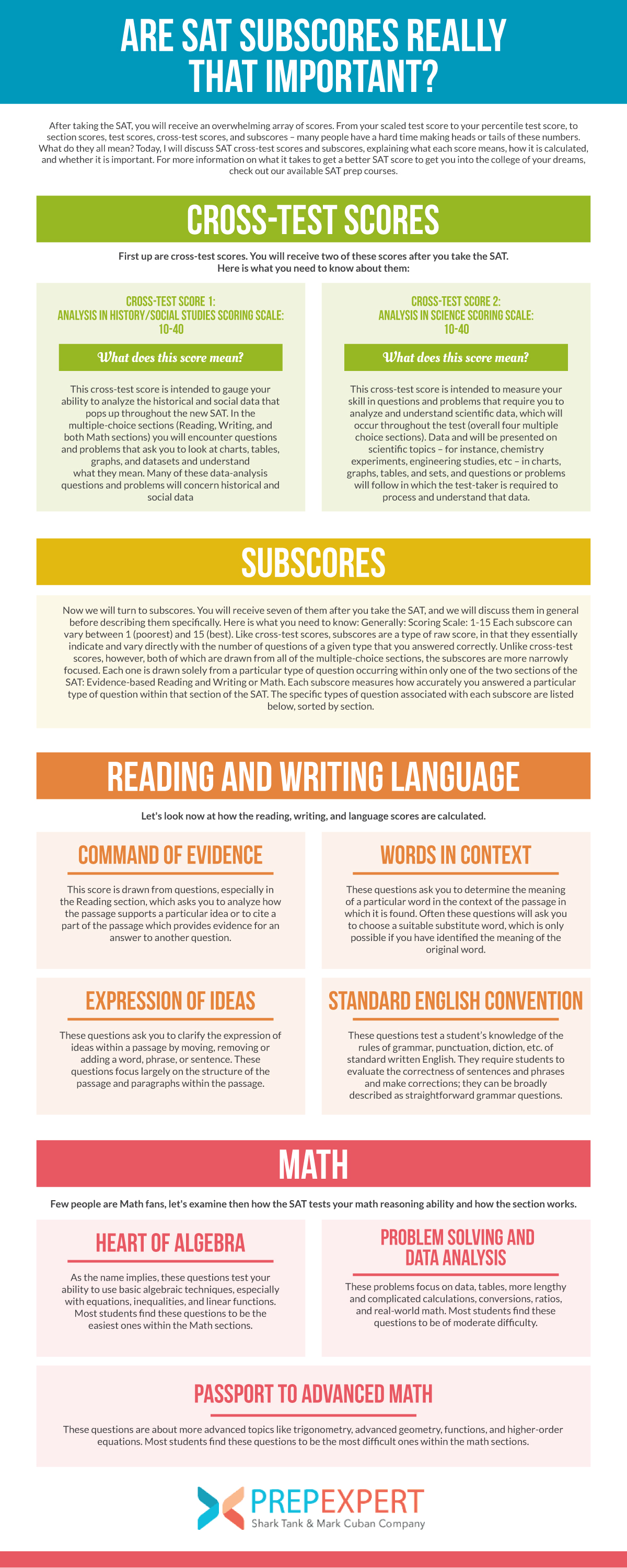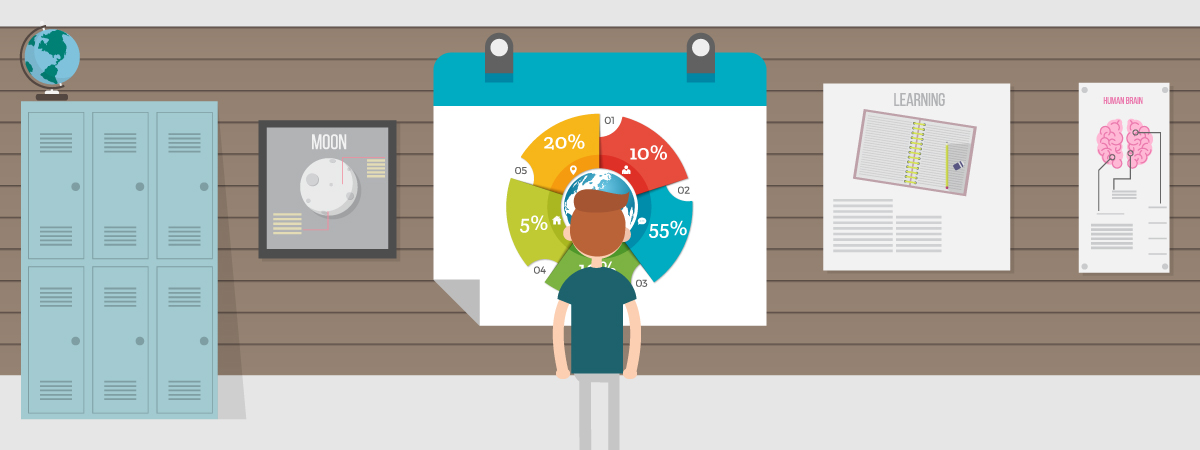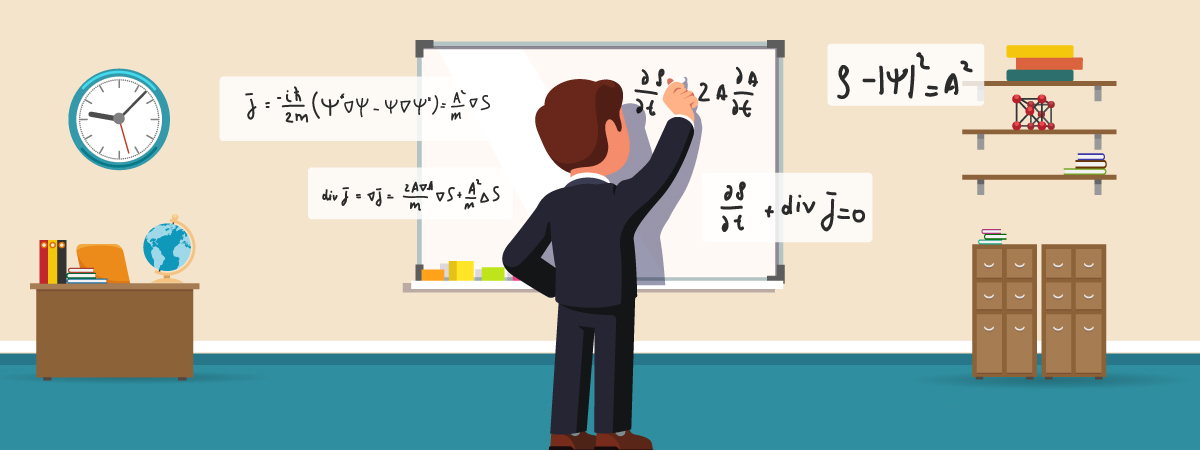Are SAT Subscores Really That Important?
After taking the SAT, you will receive an overwhelming array of scores. From your scaled test score to your percentile test score, to section scores, test scores, cross-test scores, and subscores – many people have a hard time making heads or tails of these numbers. What do they all mean?
Today, I will discuss SAT cross-test scores and subscores, explaining what each score means, how it is calculated, and whether it is important.
[sat_one]
For more information on what it takes to get a better SAT score to get you into the college of your dreams, check out our available SAT prep courses.

Cross-Test Scores
First up are cross-test scores.
You will receive two of these scores after you take the SAT. Here is what you need to know about them:
Cross-test Score 1: Analysis in History/Social Studies
Scoring scale: 10-40
What does this score mean?
This cross-test score is intended to gauge your ability to analyze the historical and social data that pops up throughout the new SAT. In the multiple-choice sections (Reading, Writing, and both Math sections) you will encounter questions and problems that ask you to look at charts, tables, graphs, and datasets and understand what they mean.
Many of these data-analysis questions and problems will concern historical and social data (for example, an essay about demographic changes within large cities, or educational attainment within specific regions); your Analysis in History/Social Studies cross-test score measures how accurately you answered these questions across all of the multiple-choice sections.
How is it calculated?
This score varies between 10 (poorest) and 40 (best), and it measures your accuracy on data-analysis questions concerning historical and/or social data. This score is more akin to a raw score (number of questions correct) than a scaled (adjusted to reflect varied performance among test-takers which tends to follow a normal distribution) or percentile scores (direct performance comparison with other test-takers). In other words, as you answer more historical or social data-analysis questions correctly, this cross-test score will proportionally increase.
Is it important?
Not terribly. Some students who anticipate studying or majoring in a field related to history or social studies, or who are applying directly to a college or program that will emphasize such studies, might place extra emphasis on doing well in this cross-test score. For the rest of us, this score is only important if it lags far behind our other scores.
[leadmagnet_five]
Cross-test Score 2: Analysis in Science
Scoring scale: 10-40
What does this score mean?
This cross-test score is intended to measure your skill in questions and problems that require you to analyze and understand scientific data, which will occur throughout the test (overall four multiple-choice sections). Data and will be presented on scientific topics – for instance, chemistry experiments, engineering studies, etc – in charts, graphs, tables, and sets, and questions or problems will follow in which the test-taker is required to process and understand that data.
How is it calculated?
This score also varies between 10 (poorest) and 40 (best). Just like the History/Social Studies cross-test score, the Analysis in Science cross-test score is akin to a raw score – it is directly related and proportional to the number of scientific data-analysis questions the student answers correctly.
Is it important?
Again, not very. If you intend to apply directly to a scientific or technical program or school, this score may be important to you. For most other students, it is only important if it is far enough below your general performance and other subscores to indicate an area that needs special attention.

Subscores
Now we will turn to subscores.
You will receive seven of them after you take the SAT, and we will discuss them in general before describing them specifically. Here is what you need to know:
Generally: Scoring Scale: 1-15
Each subscore can vary between 1 (poorest) and 15 (best). Like cross-test scores, subscores are a type of raw score, in that they essentially indicate and vary directly with the number of questions of a given type that you answered correctly.
Unlike cross-test scores, however, both of which are drawn from all of the multiple-choice sections, the subscores are more narrowly focused. Each one is drawn solely from a particular type of question occurring within only one of the two sections of the SAT: Evidence-based Reading and Writing or Math.
Each subscore measures how accurately you answered a particular type of question within that section of the SAT. The specific types of questions associated with each subscore are listed below, sorted by section.

Reading And Writing And Language
Let’s look now at how the reading, writing, and language scores are calculated.
Command of Evidence
This score is drawn from questions, especially in the Reading section, which asks you to analyze how the passage supports a particular idea or to cite a part of the passage which provides evidence for an answer to another question.
Words in Context
These questions ask you to determine the meaning of a particular word in the context of the passage in which it is found. Often these questions will ask you to choose a suitable substitute word, which is only possible if you have identified the meaning of the original word (or have identified which word should take its place using context clues); sometimes they will ask you to assess the function of the word within the passage as a whole.
Expression of Ideas
These questions ask you to clarify the expression of ideas within a passage by moving, removing or adding a word, phrase, or sentence. These questions focus largely on the structure of the passage and paragraphs within the passage; students will be asked to clarify the meaning of the passage or paragraph, maintain its tone, add, move, and delete supporting information, and generally improve coherence and effectiveness.
Standard English Conventions
These questions test a student’s knowledge of the rules of grammar, punctuation, diction, etc. of standard written English. They require students to evaluate the correctness of sentences and phrases and make corrections; they can be broadly described as straightforward grammar questions.

Math
Few people are Math fans, let’s examine then how the SAT tests your math reasoning ability and how the section works.
Heart of Algebra
As the name implies, these questions test your ability to use basic algebraic techniques, especially with equations, inequalities, and linear functions. Most students find these questions to be the easiest ones within the Math sections.
Problem Solving and Data Analysis
These problems focus on data, tables, more lengthy and complicated calculations, conversions, ratios, and real-world math. Most students find these questions to be of moderate difficulty.
[sat_two]
Passport to Advanced Math
These questions are about more advanced topics like trigonometry, advanced geometry, functions, and higher-order equations. Most students find these questions to be the most difficult ones within the math sections.

Are Any Of These Seven Subscores Important?
Just as with cross-test scores, subscores represent little more than a detailed breakdown of your performance on the test as a whole.
They thus are not especially important unless they directly bear on your specific, chosen field of study or can be useful to you as an indicator of weakness in a particular area.
Here’s the takeaway: Don’t stress much about subscores and cross-test scores. They do not represent truly different scores, just differently organized and analyzed metrics of the same ability shown by your scaled and percentile scores.
In other words, they are just different and more narrowly-focused ways of describing your performance on the test. If you prepare well and thoroughly for the test as a whole, you can expect to do well in at least most of the cross-test scores and subscores.
Moreover, it would be unwise to focus too much time and effort in your preparation for the test on any subscore or cross-test score; instead, the wise student will prep for the test as a whole and focus on his or her weakest areas throughout the prep process.
The sole exception to this general advice is if a particular cross-test score or subscore is lagging far behind general performance and performance on other subscores for a particular student; if that is the case, then the cross-test score or subscore can be a useful indicator of where to focus the most attention in further prep work.
In other words, it is safe to ignore subscores and cross-test scores for the most part during the prep process, unless one of yours is consistently far below your general performance; if that is the case, that particular cross-test score or subscore will be a useful indicator of where you need the most work.
In fact, a Prep Expert course taught by one of our 99th percentile-scoring instructors might be the perfect solution to help you shore up these weak areas; with our industry-leading Score Increase Guarantee, you will either raise your score substantially or get your money back. For those students who would prefer a more individualized, focused approach, a Prep Expert tutor is the perfect solution.
[sat_three]
For more test strategy, college admissions, and scholarship application tips sign up for our FREE class happening right now!